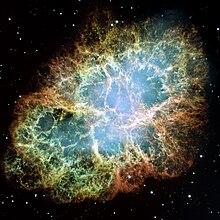 Comment: There is already an article about supernovae on Wikipedia. WikiDan61ChatMe!ReadMe!! 20:07, 5 December 2023 (UTC)
Comment: There is already an article about supernovae on Wikipedia. WikiDan61ChatMe!ReadMe!! 20:07, 5 December 2023 (UTC)

Every second, around 50 stars in the observable universe explode. These explosions are so bright, they outshine most galaxies at a remote distance. This is what's known as a supernova, which is the final stage of either a white dwarf undergoing runaway nuclear fusion or a massive star.
What causes a supernova is when the core inside of the star becomes unstable. The star releases energy by undergoing nuclear fusion, where two light nuclei merge to create a heavier atom, thus creating energy. Overtime however, after the core has exhausted using all of its hydrogen, the star can fuse helium to form more progressively heavier elements. From carbon to oxygen, it will get heavier and heavier until it reaches iron. The process of fusing iron requires more energy input than output. As a result, the core becomes unstable as its pressure decreases and the gravity around the core increases. This causes the core to collapse as gravity engulfs and thus releases an explosion that is visible anywhere near the observable universe. By far, supernovas produce more energy than anything in the observable universe.

There are two different types of supernova:
Type 1 Supernova: This only occurs in binary systems where an oxygen-carbon white dwarfs accretes matter from the other star. This over time causes the white dwarf to get too much mass, reaching its limit of around 2 x 10^9 g/cm^3. This makes the white dwarf unstable as its fusion is uncontrolled by oxygen and carbon, ultimately detonating. (Figure 1)
Type 2 Supernova: The most common one, as it occurs during the end of a massive stars life time when its fuel runs out and can no longer undergo nuclear fusion.

Type Ib Supernova: These are supernovas that show no signs of hydrogen emissions. This only occurs when stars are very massive that its strong stellar winds blows out the hydrogen from the atmosphere. This will not show any hydrogen spectral lines. These are still Type 2, as it goes through the same process.
Applying spectroscopy from light being emitted from supernovas can help us determine these classifications. Spectroscopy can help us determine supernovas to be either Type 2 or Ib. This is because when the peaks of these supernovas or shown, we can tell if they emit hydrogen emissions or not. We can also detect radiation from cobalt decay which then decays into nickel. The rate of slope from cobalt to nickel decay can tell us the different amount of energy released during a set period of time. For cobalt, the half-life is 7 days whereas nickel can be around 50 to 70 days.
Supernovas are the reason heavy elements like Iron exist. They're not only important for star formation but for life to thrive. Iron runs through our blood thanks to supernovas. The study of supernovas provides scientists with invaluable insights into fundamental astrophysical processes. They offer a glimpse into how matter behaves under extreme conditions while shedding light on topics such as galaxy evolution and the expansion of our universe itself.